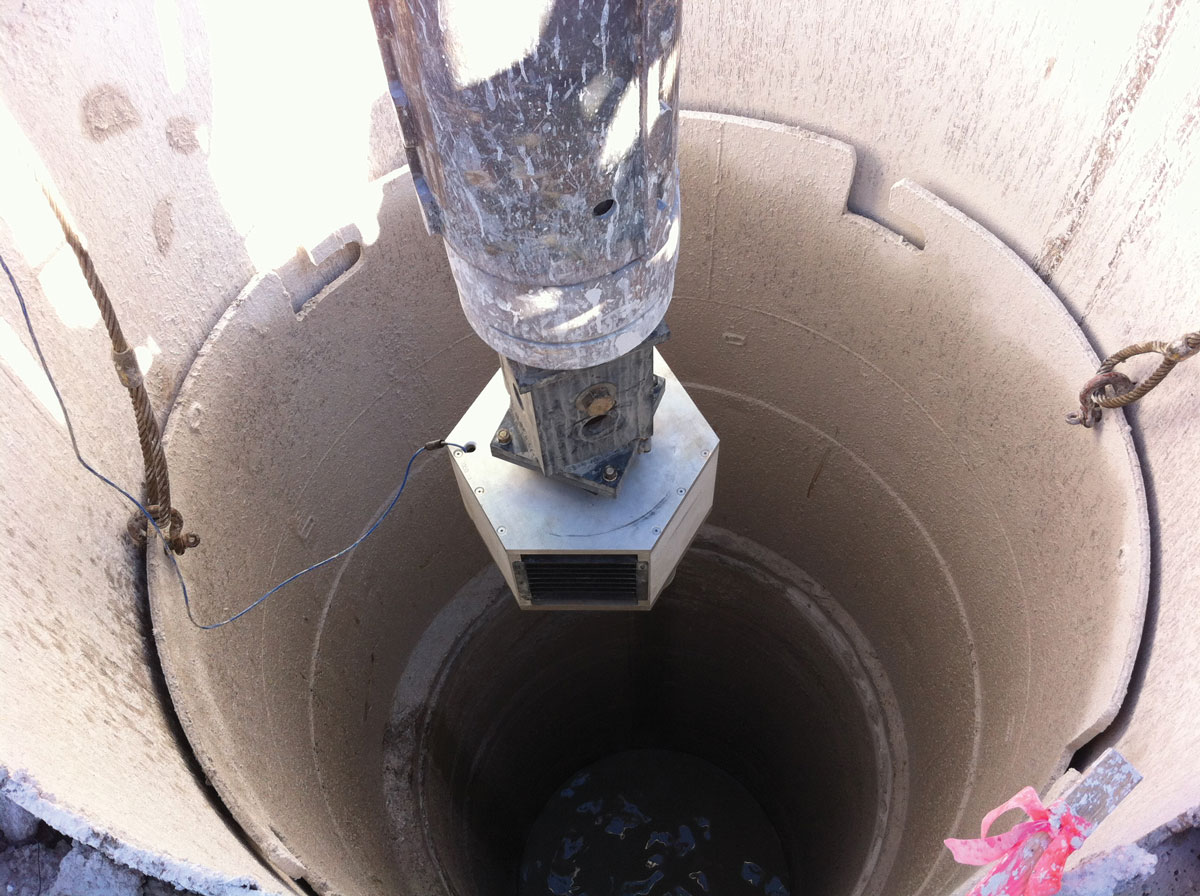
Photos: Pile Dynamics, Inc.
Pile Dynamics, Inc. (PDI)’s Shaft Quantitative Inspection Device (SQUID) is used to assess shaft base cleanliness through collected penetrometer readings. The SQUID was designed in an effort to obtain quantitative data when measuring the debris layer at the base of a drilled shaft. During the excavation of a drilled shaft, excess sediment can spill into the borehole. To meet design specifications, site crews use a cleanout bucket to remove this debris, but they aren’t able to confirm their cleanout efforts.
Within the deep foundation market, design specifications continue to evolve to ensure structural stability. The cleanliness of a drilled shaft’s base is key prior to pouring concrete. SQUID testing is a quick process that can be completed in a matter of minutes.
During a SQUID test, data is quickly collected with three penetrometers that measure force and displacement. The displacement plates remain on top of any soft material that’s present at the shaft base, while the penetrometers penetrate into any debris or soft material and record force as a function of displacement. The SQUID test can be repeated at multiple locations within the drilled shaft base area to provide a complete, objective and quantitative assessment of soft material thickness and bearing material conditions in a relatively short period of time. The data is evaluated in real-time by an engineer onsite or connected to the SQUID main unit via the internet. The need for additional cleanout, or the readiness to place concrete, can be immediately determined.

The development of SQUID was a response to the rapidly growing drilled shaft market and the need for quality assurance (QA) shaft base testing. As an industry leader in deep foundation testing, PDI quickly adapted to the market needs. If the base of the drilled shaft isn’t properly cleaned, the shaft may not perform as designed. SQUID offers a safe, cost effective and quantitative solution to help keep the project progressing. This method has been used to assess drilled shafts for bridges, building foundations, highways and railroad bridges.
A drill rig and Kelly bar are required to lower SQUID in the shaft. SQUID easily attaches to a drill rig’s Kelly bar, which is oftentimes already being used during drilled shaft construction. The downward force of the Kelly bar attached to the drill rig assists in the assessment via the penetrometers and displacement plates.
Engineers can quickly assess the debris thickness at the base of a drilled shaft without interfering with project timelines. A quality control check can provide data measurements which can be compared to the design specifications. Additionally, using SQUID can prevent shaft toe anomalies before concrete placement.
There are other devices that use cameras to assess shaft base cleanliness. However, these cameras are not the best resource for obtaining quantitative data as loose sediment can impede the camera’s view, which leaves the engineer unsure of the base’s condition and without measurements to use for reference. The data obtained from SQUID’s penetrometers and displacement plates provide a quantitative measurement of debris found at the shaft base.
Additionally, the SQUID test can typically be performed in less than half the time of other testing methods.
The data obtained from SQUID’s penetrometers and displacement plates provide a quantitative measurement of debris found at the shaft base.
Using SQUID requires a basic understanding of tablet software and the data collection process. PDI offers a variety of educational resources, including webinars and in-person seminars, along with individual product training for engineers and technicians.
In addition to SQUID, PDI offers a Shaft Area Profile Evaluator (SHAPE®), a cost-effective QA testing device that provides a real-time, visual representation (verticality, radius, volume) of foundation excavation prior to concrete pouring in wet or dry conditions. Many times, SQUID and SHAPE are used together to test multiple drilled shafts on a project. ![]()
PDI, located in Cleveland, Ohio, with offices and representatives worldwide, offers a variety of QA testing products for the deep foundations industry. For more information visit www.pile.com or contactinfo@pile.com. To learn more about product training, contact one of PDI’s sales managers at sales@pile.com. Canadian companies can purchase or rent the SQUID through PDI. To get an estimate, reach out to ttutolo@pile.com.
-
CZM Foundation Equipment introduces CZM Capital Financing options for customers
April 25, 2024 -
Student Engagement Committee
April 25, 2024 -
DFI announces two new committees
April 25, 2024 -
Keller’s John Wolosick and Allen Sehn receive awards at the 2024 Geo-Institute’s Geo-Congress
April 25, 2024 -
Rod Kern appointed as vice president of Equipment Corporation of America
April 25, 2024